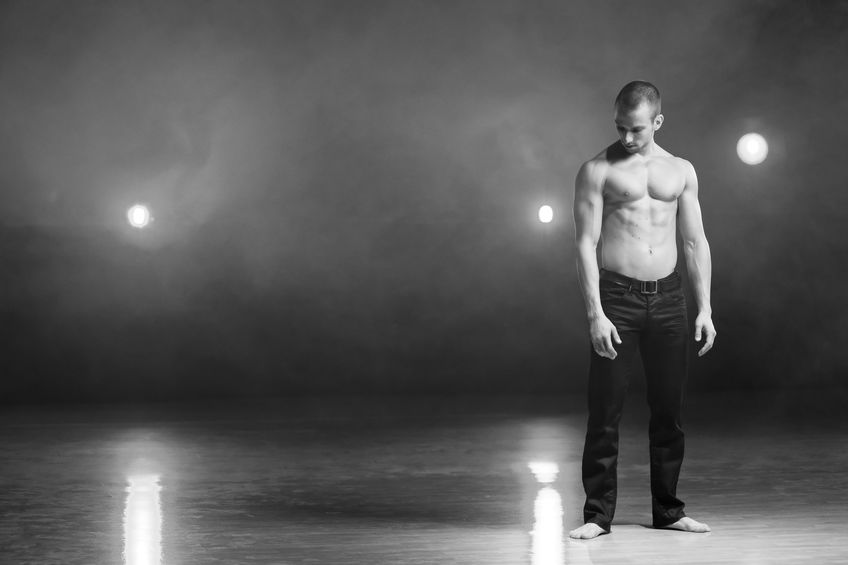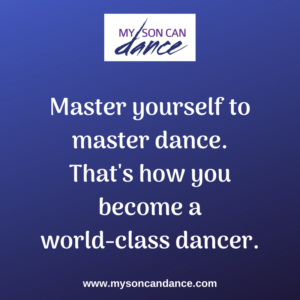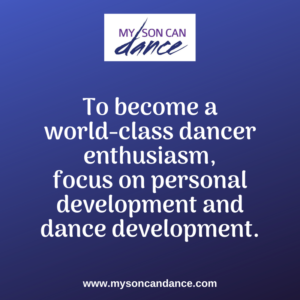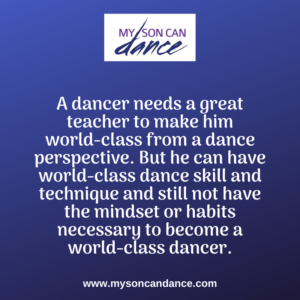 The majority of dancers focus solely on the development of their dance skills. Yet, to become a truly world-class dancer, you need more than excellent technique, performance ability, and knack for learning choreography. You also need the mindsets and habits that help you succeed.
The majority of dancers focus solely on the development of their dance skills. Yet, to become a truly world-class dancer, you need more than excellent technique, performance ability, and knack for learning choreography. You also need the mindsets and habits that help you succeed.
If you have the passion for and desire to dance, and you have even a little bit of talent for this art form, only one thing stands in the way of your success as a dancer—you.
In other words, you must master yourself to master dance. That’s how you become a world-class dancer.
Your negative thoughts, limiting beliefs, lack of courage, low self-esteem, self-defeating attitude, disorganization, trouble focusing, unsupportive habits, or low energy hold you back. To become a world-class dancer—as well as a person able to maintain healthy relationships and live life with joy, enthusiasm, and confidence, you need to work on yourself. Specifically, you need to focus on personal development as well as dance development.
Why Dancers Need Personal Development
I often get asked why a dancer would need to focus on personal development as much as the development of technique, musicality, or stage presence. The answer is simple.
If the dancer’s mindset or habits don’t allow him to step into the best version of himself, he won’t realize his potential as a dancer. Personal development and dance development go hand in hand.
And as long as the dancer is standing in his own way, he can’t reach the level so success that will make him world-class.
When a dancer begins to work on developing supportive mindsets and habits—those that support success in dance and in life—they move forward toward their dance goals much faster. They get out of their own way. They step into their best selves on stage, in class, and in life. And they achieve their dreams.
A Dancer in His Own Way
Consider this imaginary (but common) high-school or first-year professional dancer who is in his own way.
Every night after work, he grabs fast-food on his way home from the dance studio. Because he is physically tired, he sits down in front of the television or computer or pulls out his phone and begins to scroll. While doing so, he eats snacks or desserts.
His homework or pile of bills and other “things to handle” remain untouched, including a heap of laundry on the floor and dirty dishes in the sink. He figures he has time to do that later…or over the weekend.
Before he knows it, it’s late. He quickly gets ready for bed.
The alarm goes off after just six hours of somewhat restless sleep. He hits the alarm a few times, then gets up and showers. Looking at the clock, he realizes he is running late. “Damn. I’m always late,” he says aloud.
He pulls on his clothes, hurriedly stuffs his dance gear into a bag, and rushes out the door.
On the way to the studio, he grabs coffee and a donut and eats them as he walks or drives.
He arrives at the studio in the nick of time, takes his place at the barr, and manages to make it through ballet class even though he didn’t have time to warm up, stretch, or do the strengthening exercises he tells himself every day he will do—but never does.
 He drinks a bit of water during class but runs out—since he didn’t have time to fill the bottle before class.
He drinks a bit of water during class but runs out—since he didn’t have time to fill the bottle before class.
Halfway through the morning, his energy begins to lag. So he goes to the canteen and gets a Coke. He sips that, rather than water, during the next rehearsal. Even with the sugar and caffeine, he has to push hard to make it through the rest of the morning’s work.
By lunchtime, he really just wants to take a nap. He glances at his phone and notices a bunch of texts from his girlfriend and an email from his landlord, but he just turns off the phone. * I’m too busy for that now,* he thinks.
He stops to look at the bulletin board to see if he was cast in the role he wanted in the next production. He discovers that he has been cast—but in the third cast, which will not likely perform. In response to this news, he thinks, The director hates me. I’m a lousy dancer. I might as well give up. And there is definitely no reason to try harder.
Feeling lousy about himself, he goes to eat with some buddies. The heavy food he eats at lunch makes him feel better initially. Plus, he has downed a big bottle of apple juice and eaten a brownie, which has given him a sugar boost. He feels physically strong and mentally alert when he starts rehearsals, but, an hour later, his body feels like lead, and he can’t think of anything but going home and taking a nap.
So he digs in his dance bag and pulls out some candy and a bottle of water he purchased at lunch. And that gives him a short-lived burst of energy and mental clarity…enough to get him through to the end of work.
He’s too worn out afterward to stretch or go to the sauna—let alone to do the strength training he should have done first thing upon arriving at the studio. So he showers, grabs his stuff, and heads home.
And the cycle begins again—fast-food for dinner, time spent in front of screens, responsibilities left unhandled, late to bed…and another tired, rushed morning.
Issues with Going Pro Early
Does that sound like a recipe for success? No.
But it’s a common scenario for a lot of young dancers.
Dancers go pro early. I’ve known of ballerinas who started joined a professional company at age 16. Male dancers often enter a company at age 17 or 18. That means they start working as professional dancers without the four years of college most young people get to mature and learn to live on their own.
Of course, many young male dancers live away from home while studying dance through their high school years (if not earlier). They also do this without learning the life skills that come with age and experience. Typically, they have help if they need it, and supervision. (Most live in dorms or homes provided by the ballet school or dance program.) And that means that, when they enter a company, they haven’t lived outside a protected environment.
Unlike kids who go to college, they enter the workforce immediately—without every having worked or lived on their own. That, in and of itself, can create problems as they transition from school to career.
And entering a professional work environment is nothing like going away to study dance and living in a boarding school type environment (or even attending college). Suddenly, these young men must cook for themselves, pay bills on time, do their own laundry, show up to work on time, manage a schedule, and navigate company politics and relationships.
This can be tough for some.
Overcome Common Pro Dancer Struggles
Many times, dancers—even while still in school—struggle to get better roles, feel more confident, show up to class on time, handle their schedules, manage stress, do what it takes to become a better partner, eat a more healthy diet, handle their finances, have energy in class and during performances, feel motivated, or have healthy relationships in and out of dance.
The list of challenges goes on and on.
And, of course, there are the challenges that come early, early on when a young boy chooses to dance. This includes being bullied, ostracized, and teased. Sometimes it even includes having a parent—usually his father—become unsupportive.
Many young male dancers end up depressed and suicidal. They don’t have the skills to cope with difficult classmates, parental issues, or feeling different and unaccepted.
While suicidal tendencies need to be handled by a therapist, many challenges can be overcome with personal development. By focusing on self growth, you develop the habits and mindsets that help you succeed—at dance and life. As a Certified High Performance Coach, I’ve seen this over and over again with my clients—including dancers struggling with low self-esteem, lack of courage, and inability to change unsupportive habits and mindsets.
Personal development is THE number one thing that successful people invest time, money, and energy into consistently. That’s why they succeed. And that’s how they ensure continued success.
Personal Development Leads to Success
A dancer needs a great teacher or ballet master to make him a world-class dancer. But someone can have world-class dance skill and technique and still not have the mindset or habits necessary to truly become world-class.
To get the edge that helps them become world-class, dancers need specific mindsets and habits—ones proven scientifically to result in success. According to the world’s most extensive study of high performers—including Olympic athletes, performers (like Usher), celebrities (like Oprah), and Fortune 50 CEOs—successful people have made a habit of:
- Seeking clarity

- Generating energy
- Raising necessity
- Increasing productivity
- Developing influence
- Demonstrating courage
These people habitually master their:
- Psychology
- Physiology
- Effectiveness and focus
- People skills
- Presence
- Purpose
These same habits benefit dancers. In fact, these habits—including habitual ways of thinking—are proven to lead to higher degrees of success in any endeavor or life arena.
Start Personal Development at Any Time
If you or your son are sixteen or seventeen, it’s time to work on the skills that will ensure success in the studio, on stage, and in life. After all, at this age, the focus turns to pre-pro dance programs and company contracts.
If you or your son are older, it’s not too late to add personal development into the training regimen. You can work on yourself at any age and make a difference in the results you get.
Any professional dancer who is not getting the results he wants—promotions, roles, or accolades—or is struggling with life in general—handling responsibilities, developing healthy relationships, or feeling unhappy or overwhelmed, would benefit from personal development. Any dancer who wants to level up from his current level of success to a new one…and become a world-class dancer…would benefit as well.
When a dancer works on himself—especially at an early stage in his career, this one action alone can make the difference between:
- getting or not getting a contract with a ballet company
- being the best or being mediocre
- being stuck in the corps de ballet or becoming a principal dancer
A Personal Development Program for Dancers
 I’ve seen a lot of male dancers struggle—including my own son. And I am committed to helping them succeed—and thrive as dancers and as people. I want to help them become world-class dancers as well as at everything they do.
I’ve seen a lot of male dancers struggle—including my own son. And I am committed to helping them succeed—and thrive as dancers and as people. I want to help them become world-class dancers as well as at everything they do.
That’s why, after I became a Certified High Performance Coach, I created the High-Performance Dancer program. During this six-month program, I deliver the same science-backed, results-oriented sessions proven to help Olympians and other world-class athletes increase their level of success.
The High-Performance Dancer program helps dancers develop the same habits mentioned above—the ones that the highest performers develop to increase and maintain their success. Each session is delivered virtually using Zoom meeting. The only restriction on attendance is the ability to show up at the designated time and day and to have audio and video capability.
I work with dancers aged 16 and up. The groups are formed around age groups (16–18, 18–21, 21 and up). While I primarily work with male dancers, I am always happy to run a group for female dancers as well. (Contact me if you are interested in having me set up a group for your company or colleagues.) I am available for one-on-one Certified High Performance Coaching as well.
And, please share this post with any male dancers you know who might want to work on their personal development. This is THE way to succeed…the way to becoming a world-class dancer.
Answers to Common Questions about Certified High Performance Coaching
Many people don’t understand or misunderstand the term “Certified High Performance Coaching.” So, I thought I’d provide answers to commonly-asked questions about Certified High Performance Coaching that might have arisen in your mind while reading this post.
What does “high performance” mean?
High Performance means developing the behaviors and mindsets that help you succeed beyond standard norms consistently over the long-term while maintaining positive well-being and relationships.
High performance is not about working harder or for more hours. It’s not only for those in business or for Olympic athletes…although it helps them in the same ways it helps a new mom, a college student, a CFO, a dancer, or an engineer. In other words, it’s for anyone.
What is Certified High Performance Coaching?
Certified High Performance Coaching is a form of personal development or growth that is super effective with just about anyone. It’s focused on helping you become the best version of yourself and constantly find a new level of success in every area of life.
Certified High Performance Coaching is a science-backed, results-oriented, proven coaching curriculum that focuses on empowering questions, development of supportive habits, creation of success-helpful mindset, and use of specific outcome-based tools to help clients reach their next level of success in all areas of their lives. The program includes 12 core sessions and then progresses on through another 36 sessions.
Certified High Performance Coaching is nothing like “life coaching,” which is client-driven rather than outcome-driven. That’s one reason why clients report such high levels of satisfaction with Certified High Performance Coaching programs—they get results.
Are most people satisfied with the results they achieve with Certified High Performance Coaching?
Yes. In fact, the High Performance Institute—the same organization that certified me as a CHPC—sought proof of such satisfaction and teamed with a third-party company to track 37,603 CHPC sessions in 173 countries delivered by CHPCs. Here’s what they discovered: The average client satisfaction rating for Certified High Performance Coaching was 9.6 out of 10—the highest score ever recorded for any multi-month coaching program.
Is there data to prove that Certified High Performance Coaching provides specific results?
Yes. B rendon Burchard, the High Performance Institute researchers and graduates from the Master of Applied Positive Psychology (MAPP) program at the University of Pennsylvania developed a scale, called the High Performance Indicator (HPI), to measure the factors that matter most in predicting individual high performance as defined as long-term success. Based on research and proven performance improvement methods, the HPI is the world’s first validated assessment on high performance created and backed by a high performance coach (Burchard) with over a decade in the field.
rendon Burchard, the High Performance Institute researchers and graduates from the Master of Applied Positive Psychology (MAPP) program at the University of Pennsylvania developed a scale, called the High Performance Indicator (HPI), to measure the factors that matter most in predicting individual high performance as defined as long-term success. Based on research and proven performance improvement methods, the HPI is the world’s first validated assessment on high performance created and backed by a high performance coach (Burchard) with over a decade in the field.
The HPI, the largest and most comprehensive high performance study ever conducted, analyzed over 100 human performance variables in six key categories proven to relate to a person’s long-term success potential. The researchers found that: The HPI has proven to strongly correlate with external measures of success (sales performance, academic GPA performance, executive promotion odds, business unit financial success) AND important life outcomes like happiness, health, positive relationships, and confidence.
There’s more to the science of Certified High Performance Coaching. A report was published on May 15 that offers much more information on the HPI. Remember, this assessment measures the habits that lead to long-term success across domains, and it’s comprised of six subscales that separately measure clarity, energy, necessity, productivity, influence, and courage.
The two studies, with a total of 174,054 participants, showed that the HPI was predictive of several essential life outcomes:
- happiness
- confidence
- education level
- perceived excellence
- life satisfaction
- quality of interpersonal relationships
- work quality
- career impact
- income
Indeed, high performance is about leveling up EVERY area of your life. And Certified High Performance Coaching affects each life arena for just about any type of person—including dancers.
Photo copyright : Mihai Blanaru
Leave a Reply